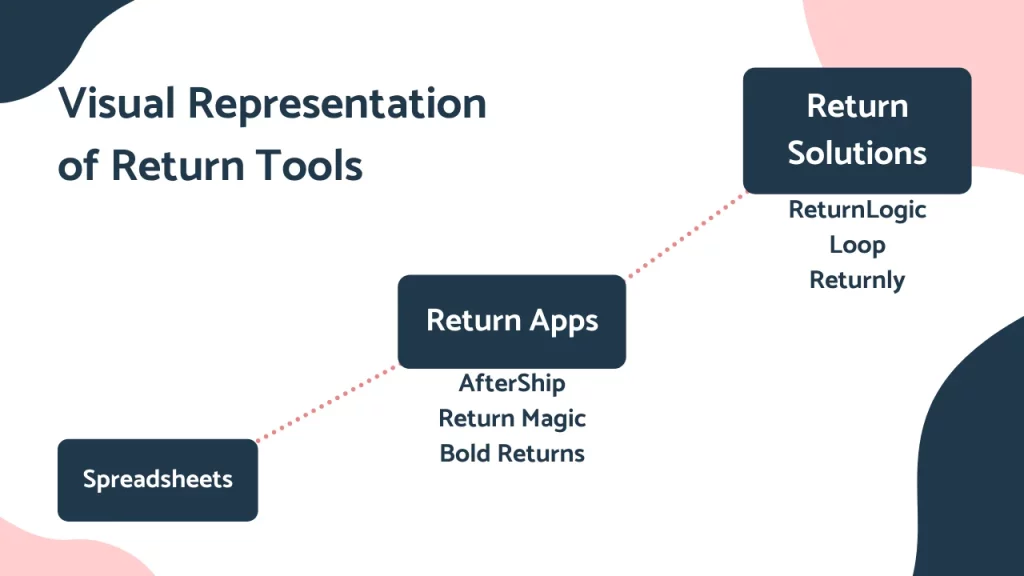Returns App vs Returns Solution: Which is Right for You?

Ecommerce has grown tremendously in recent years; the stock price of Shopify has increased nearly 10x since 2018. And COVID has rapidly accelerated the shift toward ecommerce, by an estimated 5 years, according to IBM’s U.S. Retail Index.
As a result, retailers and ecommerce brands are investing more into the systems and processes that help maximize their profits, from marketing stacks to inventory management systems and fulfillment options.
Be sure to invest in managing returns, as well.
Returns are usually not the top priority when it comes to online retail, but returns can have a pronounced impact on your profitability and can be a make-or-break moment in the customer relationship.
Managing your Ecommerce Returns
Returns management encompasses all of the policies, rules and processes that build a return for the customer, as well as the workflows and systems used by the retailer to receive, grade, and complete the return.
As in any market, there are a variety of providers who seek to ease the challenges retailers and brands face from returns. From a basic level, they can be categorized into return apps and return solutions.

Once spreadsheets are no longer viable to manage returns, you will need to implement some form of returns software. Return apps are cheaper and easier to adopt, but provide far less functionality than return solutions.
Return Apps
Return apps – such as AfterShip, Return Magic, and Bold Returns – act as a quick fix to a small subset of problems.
They simplify the customer-facing side of returns by providing a self-service returns portal, which reduces the number of emails to customer service requesting or asking about returns.
For a detailed comparison of Shopify return apps, click here.
Typically, return apps are low in both cost and commitment, and are easy to adopt. For the most part, they will make it substantially easier for customers to start returns. A return app can be a good tool as your business is starting to grow.
But as your business continues to grow, return apps will not be able to keep up with your new and evolving needs. At some point, it’s going to be time for a returns solution.
Return Solutions
Return solutions – such as ReturnLogic, Loop, and Returnly – address the more basic needs, but also aim to alleviate the deeper business challenges of returns.
They provide a self-service returns portal, just like return apps, but often support more detailed return policies and allow for greater verification against returns fraud.
It’s really the functionalities beyond the returns portal that set return solutions apart.
Many offer the ability for customer service to start returns for customers on the backend of the platform. While this is not the desired route, it allows your team to step up in the case of an angry or confused customer.
All return solutions have some functionality to accept and process returns once they arrive back at your warehouse or 3PL. Return apps simply allow customers to create returns; return solutions enable you to manage them.
Automatic return processing sets return solutions far above return apps. Automation empowers you to process returns instantly, saving hours of your time per week.
There is no one-size-fits-all threshold. As your business grows, the pains of returns will grow, as well. A common benchmark we use is that once a business reaches $1 million in annual revenue, a returns solution is usually a better option. But this basis is by no means perfect.
If the limitations of return apps aren’t as relevant to your business needs, then perhaps you can make do with a returns app for a little longer. And if your business requires more advanced rules, workflows, and capabilities, you may want to consider a returns solution earlier.
Ultimately, the decision comes down to the impact returns have on your business, and the priorities of your company.
Once returns are burdensome to where they detract from your revenue, it’s time for a returns solution. When your team is overwhelmed by emails from customers and manual tasks, a returns solution is the way to go.
As your priority shifts from solely acquiring customers more toward retaining customers and capitalizing on customer lifetime value, a returns solution becomes a much better fit.
There is no one perfect benchmark to dictate when to switch from a returns app to a returns solution, but these moments can act as solid indicators.
To Conclude
As ecommerce continues to expand, it’s important to remember that managing returns is one of the most complex challenges in online retail.
Whether your business is just starting out or is dominating ecommerce, you need an adequate strategy and tool in place to manage returns.
Both return apps and return solutions aim to alleviate the pains of returns, but each addresses a very different scope of the problem.






